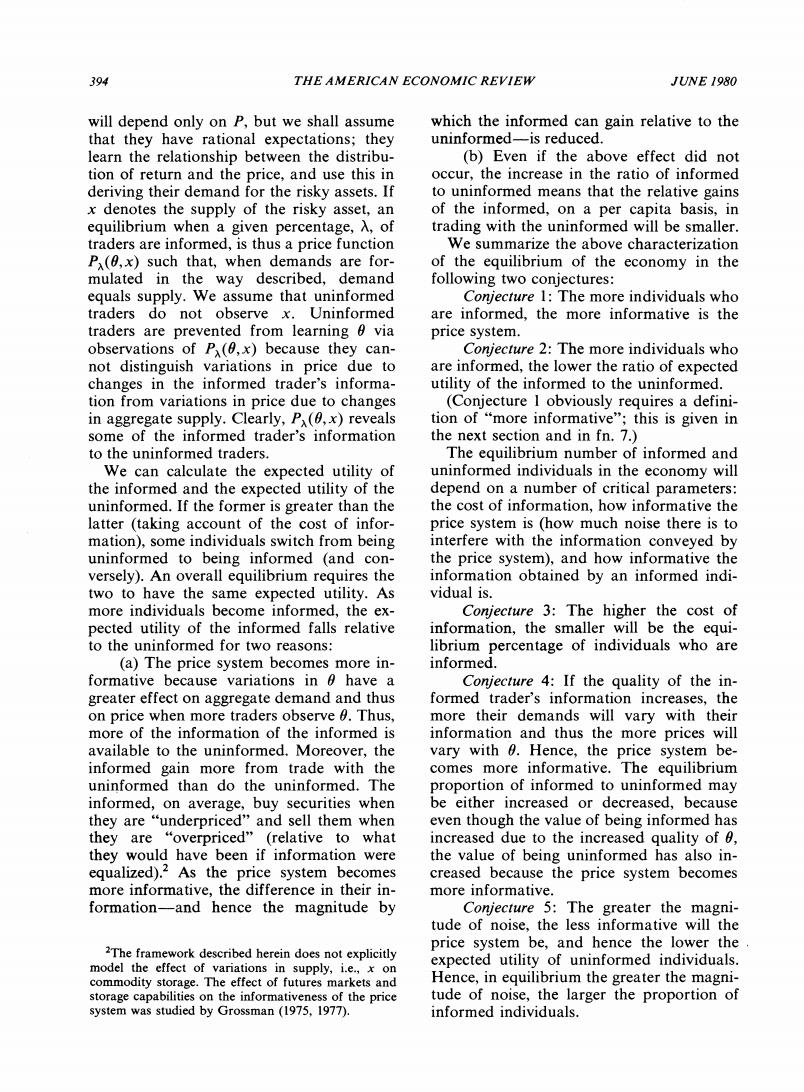正在加载图片...

394 THE AMERICAN ECONOMIC REVIEW JUNE 1980 will depend only on P,but we shall assume which the informed can gain relative to the that they have rational expectations;they uninformed-is reduced. learn the relationship between the distribu- (b)Even if the above effect did not tion of return and the price,and use this in occur,the increase in the ratio of informed deriving their demand for the risky assets.If to uninformed means that the relative gains x denotes the supply of the risky asset,an of the informed,on a per capita basis,in equilibrium when a given percentage,入,of trading with the uninformed will be smaller. traders are informed,is thus a price function We summarize the above characterization P.(,x)such that,when demands are for- of the equilibrium of the economy in the mulated in the way described,demand following two conjectures: equals supply.We assume that uninformed Conjecture 1:The more individuals who traders do not observe x.Uninformed are informed,the more informative is the traders are prevented from learning via price system. observations of P(,x)because they can- Conjecture 2:The more individuals who not distinguish variations in price due to are informed,the lower the ratio of expected changes in the informed trader's informa- utility of the informed to the uninformed. tion from variations in price due to changes (Conjecture I obviously requires a defini- in aggregate supply.Clearly,P(,x)reveals tion of "more informative";this is given in some of the informed trader's information the next section and in fn.7.) to the uninformed traders. The equilibrium number of informed and We can calculate the expected utility of uninformed individuals in the economy will the informed and the expected utility of the depend on a number of critical parameters: uninformed.If the former is greater than the the cost of information,how informative the latter (taking account of the cost of infor- price system is (how much noise there is to mation),some individuals switch from being interfere with the information conveyed by uninformed to being informed (and con- the price system),and how informative the versely).An overall equilibrium requires the information obtained by an informed indi- two to have the same expected utility.As vidual is. more individuals become informed,the ex- Conjecture 3:The higher the cost of pected utility of the informed falls relative information,the smaller will be the equi- to the uninformed for two reasons: librium percentage of individuals who are (a)The price system becomes more in- informed. formative because variations in a have a Conjecture 4:If the quality of the in- greater effect on aggregate demand and thus formed trader's information increases,the on price when more traders observe 0.Thus, more their demands will vary with their more of the information of the informed is information and thus the more prices will available to the uninformed.Moreover,the vary with 0.Hence,the price system be- informed gain more from trade with the comes more informative.The equilibrium uninformed than do the uninformed.The proportion of informed to uninformed may informed,on average,buy securities when be either increased or decreased,because they are "underpriced"and sell them when even though the value of being informed has they are“overpriced'”(relative to what increased due to the increased quality of 0, they would have been if information were the value of being uninformed has also in- equalized).As the price system becomes creased because the price system becomes more informative,the difference in their in- more informative. formation-and hence the magnitude by Conjecture 5:The greater the magni- tude of noise,the less informative will the price system be,and hence the lower the 2The framework described herein does not explicitly model the effect of variations in supply,i.e.,x on expected utility of uninformed individuals. commodity storage.The effect of futures markets and Hence,in equilibrium the greater the magni- storage capabilities on the informativeness of the price tude of noise,the larger the proportion of system was studied by Grossman (1975,1977). informed individuals